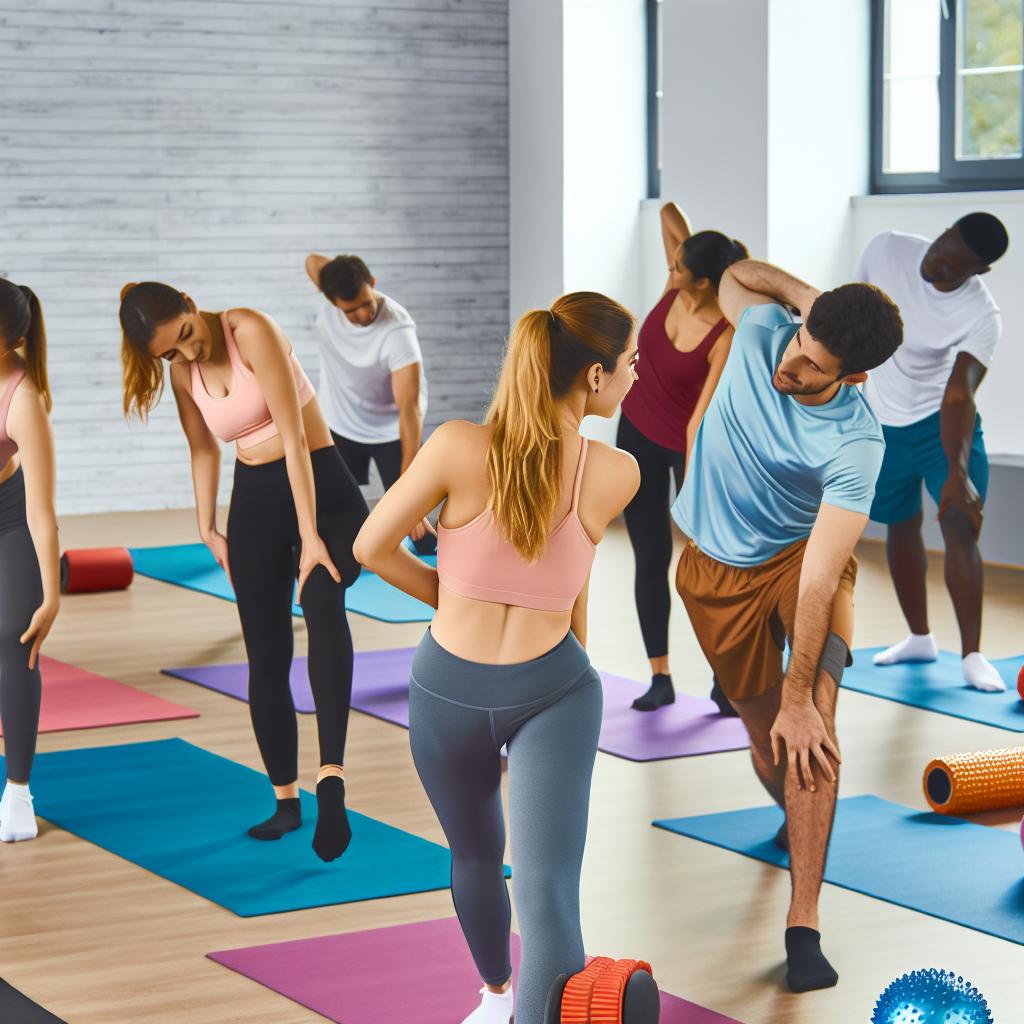Back pain is a common issue, often caused by weak muscles or poor exercise techniques. Proper gym-based exercises targeting both the upper and lower back are essential for strengthening these areas, improving posture, and preventing injuries. Discover effective methods to enhance your back strength and overall well-being with our expert guidance.
## Understanding the Importance of Proper Gym-Based Exercises for Your Upper and Lower Back
Benefits of Proper Upper and Lower Back Exercises
Engaging in proper gym-based exercises for your upper and lower back is crucial for maintaining strength, versatility, and posture. These exercises help to prevent injuries, reduce pain, and improve overall functionality. Key benefits include:
- Enhanced Posture: Strengthening back muscles supports better alignment of the spine.
- Pain Relief: targeted workouts can alleviate discomfort by strengthening surrounding muscles.
- Improved Flexibility: Regular stretching and strengthening exercises enhance the range of motion.
Key Exercises for the Back
Incorporating a variety of exercises into your routine will ensure balanced progress of both upper and lower back muscles. Here are some effective exercises:
Upper Back Exercises
- Rows: Using a cable or resistance band, pull towards your torso to strengthen upper back muscles.
- Lat Pulldowns: This targets the latissimus dorsi and improves upper back strength.
Lower Back Exercises
- Deadlifts: Essential for strengthening the entire back, especially the lower region.
- Back Extensions: These can be performed on a Roman chair to focus specifically on lower back muscles.
Maintaining Proper Form
It’s vital to perform exercises with the correct form to maximize benefits and minimize the risk of injury. consider the following tips:
- Engage Your Core: Keep your abdominal muscles tight during back exercises for better stability.
- Control Your Movements: Avoid jerky motions; perform exercises slowly and deliberately.
- Listen to Your Body: Stop if you experience pain; consult a fitness professional if uncertain.
## key Anatomy and Function of the Upper and Lower Back
Understanding the Upper Back Anatomy
The upper back, or thoracic spine, consists of 12 vertebrae and is crucial for maintaining posture and supporting the neck. Key muscles involved include the trapezius, rhomboids, and latissimus dorsi. These muscles collaborate to provide stability, facilitate movement, and enable various functional activities, such as lifting and reaching.
Upper Back Exercises
- Reverse Fly: Stand with feet shoulder-width apart, hinge at the hips, and hold weights in each hand. raise your arms to the side, squeezing the shoulder blades together. Lower and repeat.
- Seated Rows: Using a cable machine, grab the handle with both hands. Pull the handle towards your torso, keeping elbows close to your sides. Squeeze your shoulder blades at the end of the movement.
The Role of the Lower Back
The lower back, or lumbar spine, is made up of five vertebrae and plays a important role in supporting the body’s weight and facilitating movement.Significant muscles include the erector spinae and quadratus lumborum, which are essential for stabilization and movement, particularly in activities involving bending and twisting.
Lower Back Exercises
- Deadlift: Stand with your feet hip-width apart and a barbell near your shins. bend at the hips and knees, grip the bar, and lift while keeping your back straight. Engage your core throughout the movement.
- Bird-Dog: Start on all fours, extend one arm forward and the opposite leg backward. Hold for a moment, than return to the starting position. Alternate sides for balanced strengthening.
Key Differences in Function
| Aspect | Upper Back | Lower Back |
|---|---|---|
| Primary Function | Posture and movement support | Weight support and stability |
| Common Exercises | Rows, Pull-ups | Deadlifts, Back Extensions |
| Injury Risk | Strains from poor posture | Disc issues from heavy lifting |
## Essential Equipment for Effective Gym-Based Back Exercises
Key Equipment for Effective Back Workouts
To achieve optimal results in your gym-based back exercises, utilizing the right equipment is crucial. The following equipment is essential for targeting both the upper and lower back effectively:
- Pull-Up Bar: perfect for exercises like pull-ups and chin-ups,which strengthen the upper back.
- Barbell: Ideal for deadlifts and bent-over rows, allowing you to lift heavier and engage multiple back muscles.
- Dumbbells: Versatile for various exercises such as single-arm rows and lateral raises, promoting muscle symmetry.
- Resistance Bands: Excellent for warm-ups and mobility work, enhancing flexibility and stabilization.
- Cable Machine: Useful for a variety of back exercises, including seated rows and lat pulldowns, providing constant tension.
Tips for Choosing equipment
when selecting equipment, consider your fitness level and goals. Here are some tips to help:
- Start light: If your new to back exercises, begin with lighter weights to master your form.
- gradual progression: Increase weights gradually as you become more cozy with movements.
- Focus on form: Always prioritize proper technique,as this is essential to prevent injury and maximize effectiveness.
Exercises to incorporate
To build a balanced back, integrate these exercises into your routine using the mentioned equipment:
| Exercise | Target Area | Equipment Needed |
|---|---|---|
| Pull-Ups | Upper Back | Pull-Up Bar |
| Deadlifts | lower Back | Barbell |
| Dumbbell Rows | Middle Back | Dumbbells |
| Cable Lat Pulldowns | Upper Back | Cable Machine |
## Step-by-Step guide to Properly Executing Upper Back Exercises
Understanding Proper Form
When it comes to executing upper back exercises, maintaining proper form is crucial for maximizing effectiveness and preventing injury. Start by ensuring your posture is correct:
- Feet: Position them shoulder-width apart for stability.
- Knees: Keep them slightly bent; don’t lock them.
- Core: Engage your core muscles to support your spine.
- Shoulders: Draw your shoulders back and down, away from your ears.
Step-by-Step Execution
Follow these steps to perform effective upper back exercises:
1. Pull-Ups
- Grip the pull-up bar with palms facing away, hands slightly wider than shoulder-width.
- Hang fully,arms extended,then pull yourself up untill your chin is above the bar.
- Lower yourself slowly to the starting position for control and to engage muscles effectively.
2. Bent-Over Rows
- Stand with feet hip-width apart, holding dumbbells in each hand.
- bend at the hips and knees, keeping your back straight, and let the weights hang directly below you.
- Pull the weights towards your torso, squeezing your shoulder blades together, then lower them back down.
Common Mistakes to Avoid
To ensure your workout is effective, be mindful of these common errors:
- Rounding your back: Always keep your back straight to avoid strain.
- Using momentum: Focus on slow, controlled movements rather than swinging weights.
- Narrow grip: Ensure your grip allows for proper engagement of upper back muscles.
## Step-by-Step Guide to Properly Executing Lower Back Exercises
Understanding Your Body Mechanics
Properly executing lower back exercises begins with understanding your body mechanics. Maintaining a neutral spine position is crucial to prevent injury. When bending or lifting, engage your core to support your lower back. Here’s how:
- stand tall with your feet shoulder-width apart.
- Brace your core by tightening your abdominal muscles.
- Keep your back straight and bend from your hips, not your waist.
Key Lower Back Exercises
1. Cat-Cow Stretch
This dynamic stretch helps improve flexibility and relieve tension in the lower back.
- Start on all fours with your hands under your shoulders and knees under your hips.
- Inhale as you arch your back (Cow) and lift your head and tailbone.
- Exhale as you round your back (Cat), tucking your chin and tailbone.
- Repeat for 8-10 reps.
2. Bird-Dog
This exercise enhances balance and stability while strengthening the back.
- Begin on all fours as in the previous exercise.
- Extend your right arm forward and left leg back simultaneously, keeping your hips square to the ground.
- Hold for a few seconds, then return and switch sides.
- Complete 8-10 reps on each side.
3. glute Bridges
Glute bridges strengthen the glutes and lower back,providing essential support.
- Lie on your back with knees bent and feet flat on the ground, shoulder-width apart.
- Press thru your heels and squeeze your glutes as you raise your hips toward the ceiling.
- Hold for a count of three, then lower back down.
- Aim for 10-15 reps.
Tips for Safe Execution
to enhance the effectiveness of your lower back exercises and prevent injury, remember the following:
- Always warm up before starting your routine to prepare your muscles.
- listen to your body; if an exercise causes pain, stop promptly.
- Incorporate stretching after your workout to promote flexibility.
- Consider using light weights or resistance bands as you gain strength.
## Incorporating Stretching and Mobility Work into Your Back Routine
Dynamic Stretching for Your Back
Incorporating dynamic stretching into your back routine helps improve flexibility and enhances mobility. Before engaging in any intensive workout, perform these movements to warm up:
- Arm Circles: Stand with feet shoulder-width apart and circle your arms forward and backward for 30 seconds each.
- Torso Twists: Stand tall and twist your upper body from side to side, allowing your arms to swing gently to promote spinal mobility.
- Cat-Cow Stretch: Get on all fours and alternate arching your back and rounding it, syncing your breath for 1 minute.
Static Stretching After Workouts
After strengthening your back with gym exercises,it’s crucial to perform static stretching to alleviate tension and improve recovery:
- Child’s Pose: Kneel on the floor,sit back on your heels,and reach your arms forward; hold for 30 seconds.
- Cobra Stretch: Lie face down, press your hands into the ground, and lift your chest while keeping your hips down; hold for 20-30 seconds.
- Seated Forward Bend: Sit with legs extended, reach towards your toes, and hold the position to stretch your lower back.
Incorporating Mobility Work
Beyond stretching, incorporating mobility exercises in your routine will enhance your range of motion and prevent injury:
- Hip Openers: use a resistance band to perform hip circles, which benefit your lower back alignment.
- Thoracic Extensions: In a seated position, clasp your hands and gently arch your upper back against a wall to open up tight thoracic muscles.
- foam Rolling: Integrate foam rolling into your routine to release tightness in the back muscles effectively.
Make sure to dedicate time for these stretching and mobility work routines at least three times a week for optimal results, ensuring your upper and lower back remains strong and healthy.
## Common Challenges in Back Training and How to Overcome Them
Identifying Common Challenges
Training the back can present several challenges, including muscle imbalances, poor form, and lack of flexibility. Understanding these obstacles is essential for developing an effective fitness routine. Here are some common challenges in back training:
- muscle Imbalances: Overworking certain muscles while neglecting others can lead to pain and injury.
- Poor Form: Incorrect posture during exercises can exacerbate existing issues and hinder progress.
- lack of Flexibility: Tight muscles can restrict movement, making it tough to perform exercises effectively.
Strategies to Overcome Challenges
To enhance your back training regimen and prevent injury, consider the following strategies:
1. Focus on muscle Balance
Incorporate a variety of exercises that target both the upper and lower back. Ensure your routine includes:
- Strengthening exercises for weak areas (like the rhomboids and lower back).
- Stretching routines for tight muscles (such as the chest and hip flexors).
2. Maintain Proper Form
Utilize these tips to ensure correct posture during workouts:
- Use a mirror to check your form.
- Engage your core to support your spine.
- Perform each movement slowly to focus on technique.
3. Improve Flexibility
Add stretching exercises to your routine. Effective stretches include:
- Cat-Cow Stretch: Enhances spine flexibility.
- Child’s Pose: Relieves tension in the back.
- Torso Twist: Increases range of motion.
Creating a Balanced Routine
Create a balanced back training regimen by integrating both strengthening and stretching exercises. Aim to dedicate at least 2-3 days per week to focused back workouts, alternating between different muscle groups to ensure comprehensive coverage.
## Tips for Preventing Injury During Back Exercises in the Gym
Start Slowly and Progress Gradually
When engaging in back exercises, it’s crucial to begin with lighter weights and simple movements. This helps your muscles adapt and reduces the likelihood of injury:
- Choose weights that you can lift comfortably for 10-15 repetitions.
- Increase weight gradually; step up by no more than 5-10% at a time.
- Focus on form over quantity to ensure that you are performing each exercise correctly.
use proper Technique
Maintaining correct form is essential to prevent injury during back workouts. follow these guidelines:
- Keep your spine neutral and avoid rounding or over-extending your back.
- Breathe throughout the exercise; don’t hold your breath.
- Engage your core muscles to provide stability while performing lifts.
Key Techniques to Remember:
| Technique | Importance |
|---|---|
| Neutral Spine | Reduces strain on your back and prevents injury. |
| Controlled Movements | maintains muscle engagement and prevents jerking motions. |
| Core Engagement | Supports your back and improves overall stability. |
listen to Your Body
Pay attention to any signs of discomfort or pain during your exercises.Key practices include:
- stop immediately if you feel sharp pain or discomfort.
- Modify or skip exercises that do not feel right for you.
- Consult a fitness professional to review your technique if uncertain.
## Encouraging Recovery: Home Remedies and Aftercare Techniques for Your Back
Home Remedies for Back pain relief
implementing simple home remedies can significantly contribute to your recovery from back pain. Consider the following techniques:
- Cold Therapy: Apply an ice pack wrapped in a cloth to the affected area for 15-20 minutes several times a day. This can help reduce inflammation and numb sharp pain.
- Heat Therapy: After the first 48 hours of injury, switch to heat. Use a heating pad or warm bath to relax tight muscles and improve blood flow.
- Gentle Stretching: Incorporate gentle stretches into your daily routine to maintain flexibility and alleviate tension.
Essential Stretches for Recovery
Here are a few effective stretches that can aid in recovery:
- Cat-Cow Stretch: On all fours, alternate between arching your back (cat) and dropping your belly (cow) to relieve spinal tension.
- Knees to Chest: Lying on your back, pull your knees gently toward your chest and hold for 15-30 seconds to stretch the lower back.
- Child’s Pose: Kneel on the floor, sit back on your heels, and stretch your arms forward on the ground to gently elongate the spine.
Aftercare Techniques for optimal Recovery
Post-exercise aftercare is crucial for back health. Focus on these techniques:
- Stay Hydrated: Proper hydration supports muscle function and recovery. Aim for at least 8 glasses of water a day.
- Rest and Recover: Allow your body time to heal.getting adequate rest is essential for muscle recovery.
- Consult a Professional: If pain persists, consider seeing a physical therapist or chiropractor for tailored advice and treatment options.
Daily Recovery Checklist
| Action | Frequency |
|---|---|
| Ice or Heat Application | As needed (every 2-3 hours) |
| Gentle Stretches | 2-3 times daily |
| Hydration | Throughout the day |
| Rest Period | As required, avoid strenuous activities |
FAQ
### What are the best gym exercises for strengthening my upper back?
To strengthen your upper back, consider incorporating exercises that specifically target the latissimus dorsi, trapezius, and rhomboid muscles. Some effective exercises include:
– **Bent-over rows**: Using dumbbells or a barbell, hinge at the hips while keeping your back straight, and lift the weights towards your chest, squeezing your shoulder blades together.
– **Pull-ups or chin-ups**: these compound movements work the upper back extensively. If you’re a beginner, use an assisted pull-up machine or resistance bands for support.
– **Seated cable rows**: Sit at a cable machine, grasp the handle with both hands, and pull it towards your abdomen while maintaining a straight back and engaging your core.
When performing these exercises, **focus on form**.Aim for 3 sets of 8-12 repetitions,gradually increasing weight as you build strength. **Consistency** is key; aim to include upper back exercises in your routine 2-3 times per week for best results.
### how can I ensure I’m using proper form during back exercises?
Proper form is crucial to prevent injuries and maximize the effectiveness of your workouts. Here are specific tips to maintain good form:
– **Keep a neutral spine**: Avoid rounding your back by keeping your chest lifted and shoulders down.
– **Engage your core**: Brace your abdominal muscles to provide stability during movements.
– **Mind your grip**: Use a grip that feels comfortable for you. A wider grip engages a different set of muscles compared to a narrower grip.
To check your form, consider working with a fitness professional initially. Additionally, watching yourself perform exercises in a mirror can help ensure you maintain the correct posture throughout your workout. Remember, it’s better to lift lighter weights with proper form than to risk injury by lifting heavier weights incorrectly.
### How frequently enough should I train my upper and lower back?
The frequency of training your back can depend on your overall fitness goals and routine. Generally, training each muscle group **2-3 times per week** is recommended for optimal strength gains and recovery. Here’s a simple breakdown:
– **Split Routine**: If you’re following a split routine, focus on your upper back separately from your lower back. This allows for targeted training, giving each group adequate recovery time.
- **Full Body Workouts**: If you do full-body workouts, make sure to include back exercises in each session, adjusting volume and intensity to avoid overtraining.
Listening to your body is essential. If you’re experiencing soreness or fatigue, consider taking an additional day of rest. Adequate recovery is key to muscle growth and preventing injuries.
### What are effective stretches to complement back workouts?
Integrating stretches into your fitness routine can significantly improve flexibility and help prevent injuries. Here are a few effective stretches for your back:
– **Child’s Pose**: Kneel on the floor, sit back on your heels, and stretch your arms forward on the ground. This position helps gently stretch the spine.
– **Cat-Cow Stretch**: Get on all fours and alternate between arching your back (cat) and dropping your belly toward the floor (cow). This movement warms up the spine and increases flexibility.
– **Thoracic Spine Twist**: While seated or standing, rotate your torso to one side while keeping your hips stable. this stretch targets the upper back and shoulders.
Incorporate these stretches after your workouts to enhance recovery and flexibility. Aim for 15-30 seconds per stretch, breathing deeply and relaxing into each position.
### What equipment is best for back workouts at the gym?
When it comes to training your back, various equipment can maximize your workouts. Here’s a look at some key tools:
– **Free weights**: Dumbbells and barbells are excellent for both upper and lower back exercises (e.g., rows and deadlifts).
– **Cable machines**: These machines are versatile, allowing you to perform a range of exercises like seated rows and face pulls with controlled resistance.
– **Resistance bands**: Perfect for beginners or as a supplement to heavier workouts, bands can enhance stability and provide resistance for various back exercises.
– **Smith machine**: This can be a useful tool for safely performing squats and deadlifts, especially for targeting the lower back.
Select equipment based on your comfort level and accessibility.It’s also beneficial to combine different types of equipment to challenge your muscles in varied ways.
### How do I avoid common injuries while training my back?
Preventing injuries during back workouts is critical for maintaining long-term fitness. Here are key strategies to help you stay safe:
- **Warm-up properly**: Spend at least 5-10 minutes warming up with dynamic movements to increase blood flow to your muscles.
– **listen to your body**: If you feel sharp pain during an exercise, stop immediately. Discomfort can be a sign of inadequate form or overexertion.
– **Gradually increase intensity**: Don’t rush into lifting heavier weights. Progress gradually, allowing your muscles to adapt to new challenges.
Incorporate rest days into your routine. Recovery is just as important as training; this helps your muscles repair and grow stronger, lowering the risk of injury. Always prioritize your body’s feedback to ensure a safe and effective workout experience.
The Way Forward
## Conclusion: Strengthening Your Back
As you conclude your journey to mastering gym-based exercises for your upper and lower back, remember that consistency and proper technique are key. Follow these final steps to ensure your back remains strong and healthy:
### Key Takeaways
– **warm-Up First**: Always begin with a proper warm-up to prepare your muscles and prevent injury.
– **Focus on Form**: Prioritize correct form over the amount of weight lifted. This will help you avoid injuries and ensure that you are effectively targeting the right muscles.
– **engage Your Core**: A strong core supports your back. Incorporate core-strengthening exercises into your routine.
– **Cool Down and Stretch**: After your workout, spend time cooling down and stretching. This helps with recovery and flexibility.
### Encouragement to Act
– Whether you are new to these exercises or have experience, start at your own pace. Gradually increase weights and reps as you become more comfortable.
– Don’t hesitate to seek guidance from a professional trainer to refine your technique and customize your workout plan.
### Remember
– A strong back is essential for overall health and well-being. Regularly incorporating proper exercises will not only enhance your strength but also improve your posture and reduce pain.
– Celebrate your progress, no matter how small. Every step you take towards strengthening your back contributes to a healthier you.
Take these tips to the gym, stay committed, and enjoy the journey to a stronger back!










